2015 MERCEDES-BENZ S-Class hybrid
[x] Cancel search: hybridPage 52 of 502

This poses an increased risk of injury or even
fatal injury.
Never modify parts of the restraint system.
Never tamper with the wiring, the electronic
components or their software.
If it is necessary to modify an air bag system to accommodate a person with disabilities, con-
tact an authorized Mercedes-Benz Center for
details. USA only: for further information con- tact our Customer Assistance Center at
1-800-FOR-MERCedes (1‑800‑367‑6372). Restraint system warning lamp
The functions of the restraint system are
checked after the ignition is switched on and at regular intervals while the engine is run-
ning. Therefore, malfunctions can be detec-
ted in good time.
The 6 restraint system warning lamp in
the instrument cluster lights up when the igni-
tion is switched on. It goes out no later than a few seconds after the vehicle is started. The
components of the restraint system are in
operational readiness.
A malfunction has occurred if the 6
restraint system warning lamp:
R does not light up after the ignition is
switched on
R does not go out after a few seconds with
the engine running
R lights up again while the engine is running
All vehicles, except hybrid vehicles: G
WARNING
If restraint system is malfunctioning, restraint system components may be triggered unin-
tentionally or might not be triggered at all in
the event of an accident with a high rate of
vehicle deceleration. This can affect the Emer- gency Tensioning Device or air bag, for exam-
ple. This poses an increased risk of injury or
even fatal injury. Have the restraint system checked and
repaired in a qualified specialist workshop as soon as possible.
Hybrid vehicles: G
DANGER
If the restraint system is malfunctioning, indi- vidual restraint system components may be
triggered unintentionally or might not be trig-
gered at all in the event of an accident with a high rate of vehicle deceleration. This could
affect Emergency Tensioning Devices or air
bags, for example. The vehicle's high-voltage
electrical system may also not be deactivated
as intended in the event of an accident. You
could suffer an electric shock if you touch the damaged components of the vehicle's high-
voltage electrical system. This poses an
increased risk of injury or even fatal injury.
Have the restraint system checked and
repaired immediately at a qualified specialist
workshop. Immediately switch off the ignition
and remove the SmartKey from the ignition
lock after an accident. PASSENGER AIR BAG indicator lamp
PASSENGER AIR BAG OFF indicator lamp
:
and PASSENGER AIR BAG ON indicator
lamp ;are part of the Occupant Classifica-
tion System (OCS).
The indicator lamps display the status of the
front-passenger front air bag.
R PASSENGER AIR BAG OFF :lights up: the
front-passenger front air bag is deactiva- 50
Occupant safetySafety
Page 71 of 502
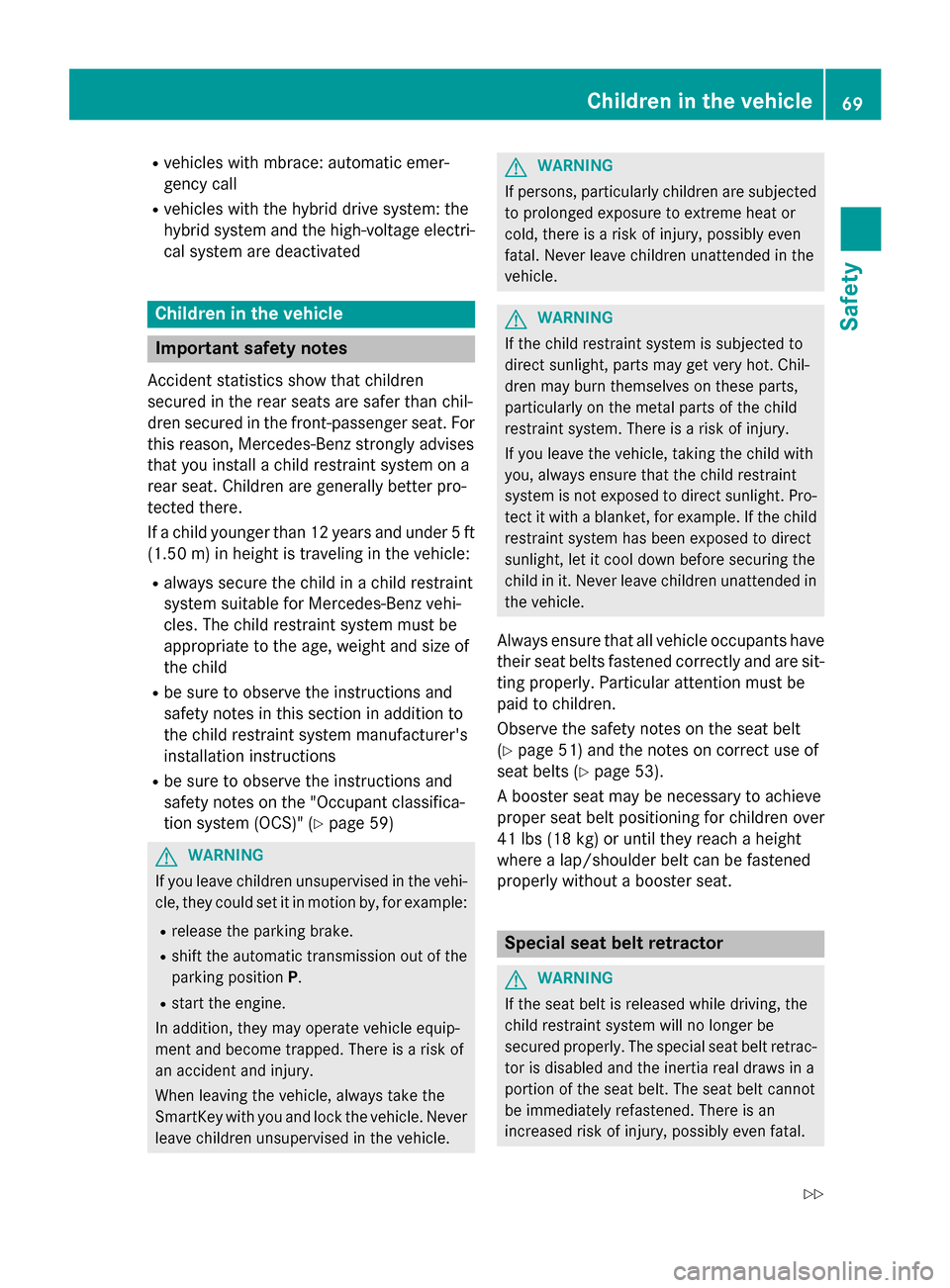
R
vehicles with mbrace: automatic emer-
gency call
R vehicles with the hybrid drive system: the
hybrid system and the high-voltage electri-
cal system are deactivated Children in the vehicle
Important safety notes
Accident statistics show that children
secured in the rear seats are safer than chil-
dren secured in the front-passenger seat. For this reason, Mercedes-Benz strongly advises
that you install a child restraint system on a
rear seat. Children are generally better pro-
tected there.
If a child younger than 12 years and under 5 ft
(1.50 m) in height is traveling in the vehicle:
R always secure the child in a child restraint
system suitable for Mercedes-Benz vehi-
cles. The child restraint system must be
appropriate to the age, weight and size of
the child
R be sure to observe the instructions and
safety notes in this section in addition to
the child restraint system manufacturer's
installation instructions
R be sure to observe the instructions and
safety notes on the "Occupant classifica-
tion system (OCS)" (Y page 59)G
WARNING
If you leave children unsupervised in the vehi- cle, they could set it in motion by, for example:
R release the parking brake.
R shift the automatic transmission out of the
parking position P.
R start the engine.
In addition, they may operate vehicle equip-
ment and become trapped. There is a risk of
an accident and injury.
When leaving the vehicle, always take the
SmartKey with you and lock the vehicle. Never
leave children unsupervised in the vehicle. G
WARNING
If persons, particularly children are subjected to prolonged exposure to extreme heat or
cold, there is a risk of injury, possibly even
fatal. Never leave children unattended in the
vehicle. G
WARNING
If the child restraint system is subjected to
direct sunlight, parts may get very hot. Chil-
dren may burn themselves on these parts,
particularly on the metal parts of the child
restraint system. There is a risk of injury.
If you leave the vehicle, taking the child with
you, always ensure that the child restraint
system is not exposed to direct sunlight. Pro- tect it with a blanket, for example. If the child
restraint system has been exposed to direct
sunlight, let it cool down before securing the
child in it. Never leave children unattended in the vehicle.
Always ensure that all vehicle occupants have
their seat belts fastened correctly and are sit- ting properly. Particular attention must be
paid to children.
Observe the safety notes on the seat belt
(Y page 51) and the notes on correct use of
seat belts (Y page 53).
A booster seat may be necessary to achieve
proper seat belt positioning for children over
41 lbs (18 kg) or until they reach a height
where a lap/shoulder belt can be fastened
properly without a booster seat. Special seat belt retractor
G
WARNING
If the seat belt is released while driving, the
child restraint system will no longer be
secured properly. The special seat belt retrac- tor is disabled and the inertia real draws in a
portion of the seat belt. The seat belt cannot
be immediately refastened. There is an
increased risk of injury, possibly even fatal. Children in the vehicle
69Safety
Z
Page 169 of 502
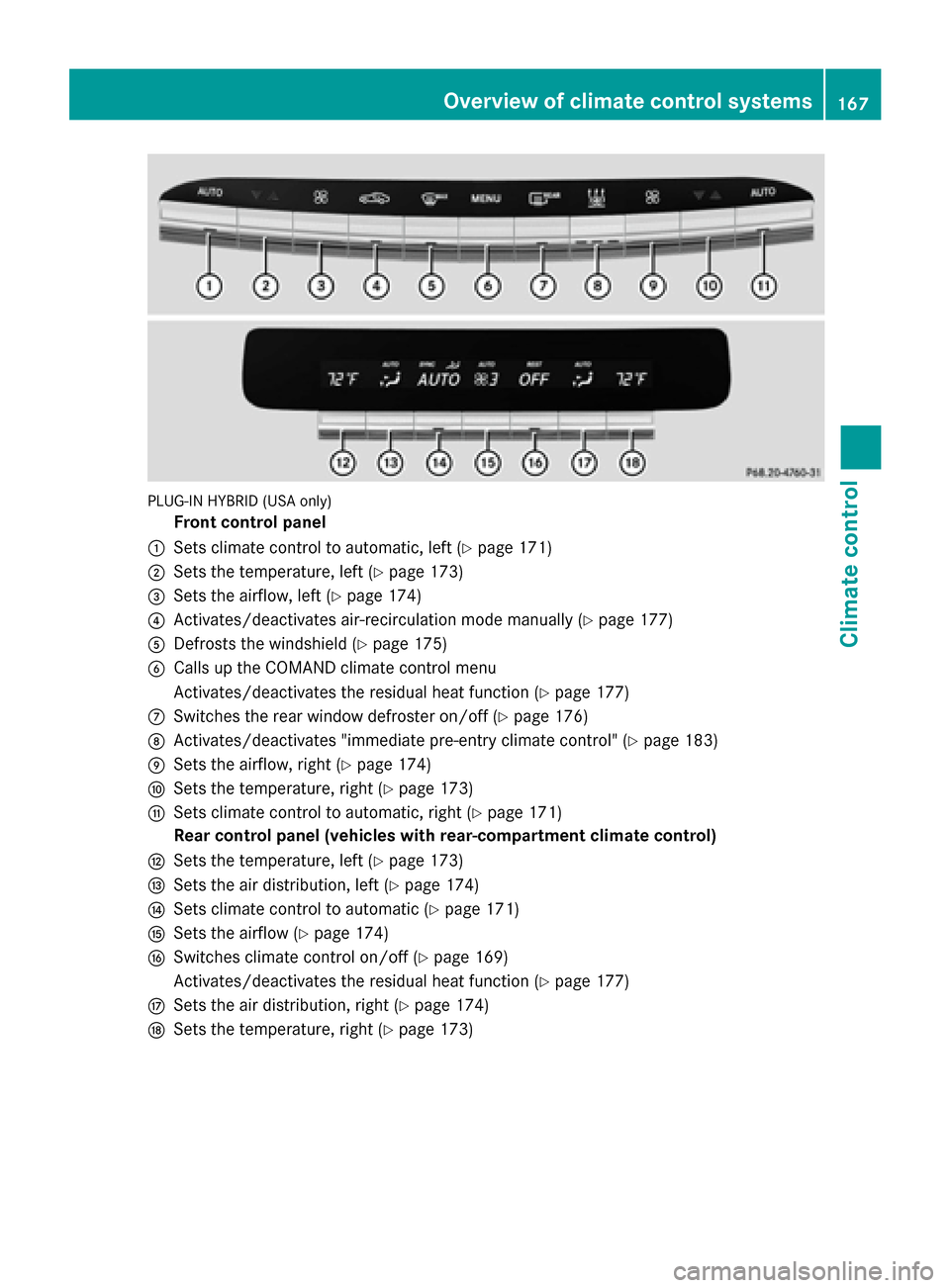
PLUG-IN HYBRID (USA only)
Front control panel
: Sets climate control to automatic, left (Y page 171)
; Sets the temperature, left (Y page 173)
= Sets the airflow, left (Y page 174)
? Activates/deactivates air-recirculation mode manually (Y page 177)
A Defrosts the windshield (Y page 175)
B Calls up the COMAND climate control menu
Activates/deactivates the residual heat function (Y page 177)
C Switches the rear window defroster on/off (Y page 176)
D Activates/deactivates "immediate pre-entry climate control" (Y page 183)
E Sets the airflow, right (Y page 174)
F Sets the temperature, right (Y page 173)
G Sets climate control to automatic, right (Y page 171)
Rear control panel (vehicles with rear-compartment climate control)
H Sets the temperature, left (Y page 173)
I Sets the air distribution, left (Y page 174)
J Sets climate control to automatic (Y page 171)
K Sets the airflow (Y page 174)
L Switches climate control on/off (Y page 169)
Activates/deactivates the residual heat function (Y page 177)
M Sets the air distribution, right (Y page 174)
N Sets the temperature, right (Y page 173) Overview of climate control systems
167Climate control
Page 170 of 502
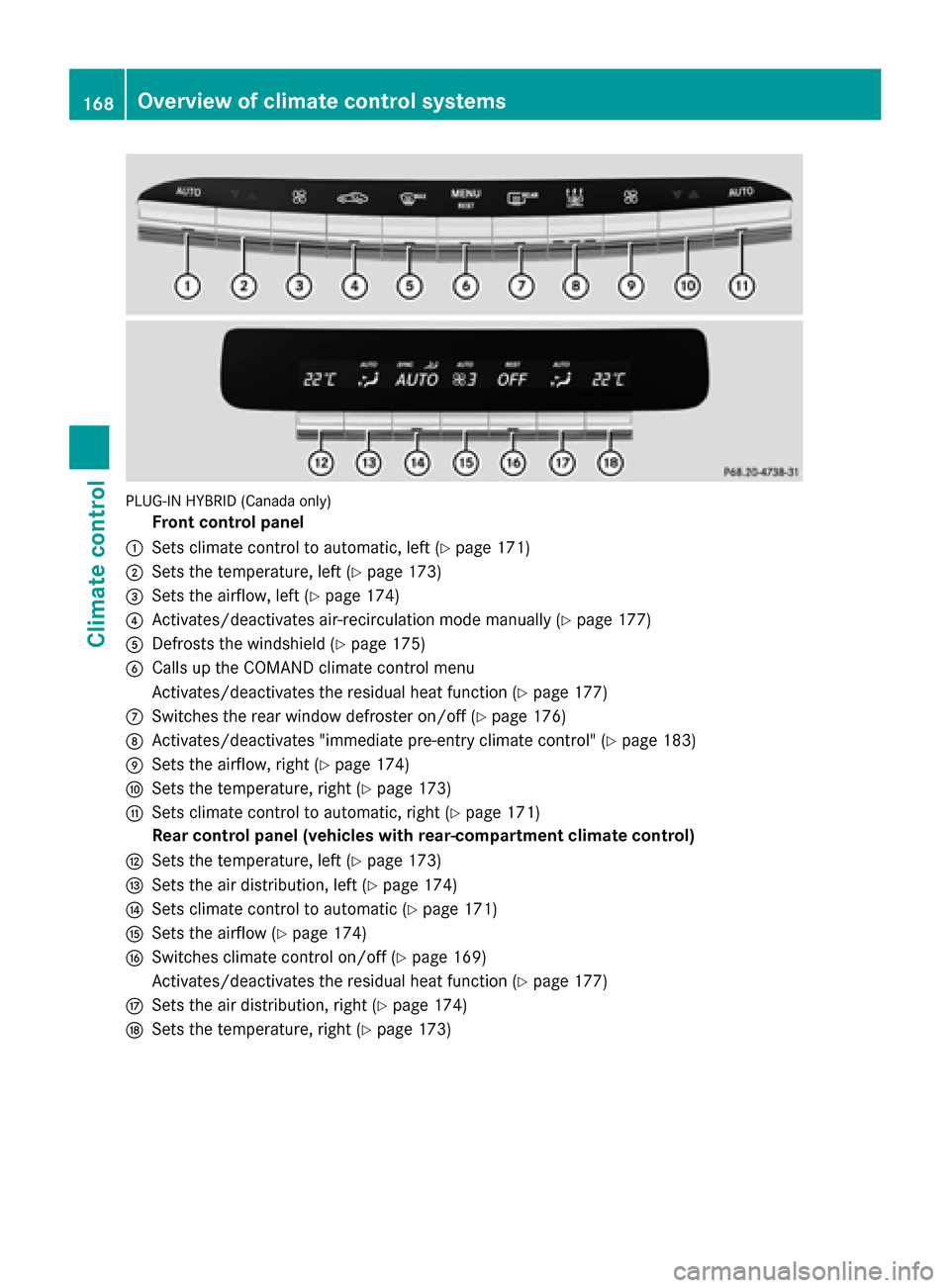
PLUG-IN HYBRID (Canada only)
Front control panel
: Sets climate control to automatic, left (Y page 171)
; Sets the temperature, left (Y page 173)
= Sets the airflow, left (Y page 174)
? Activates/deactivates air-recirculation mode manually (Y page 177)
A Defrosts the windshield (Y page 175)
B Calls up the COMAND climate control menu
Activates/deactivates the residual heat function (Y page 177)
C Switches the rear window defroster on/off (Y page 176)
D Activates/deactivates "immediate pre-entry climate control" (Y page 183)
E Sets the airflow, right (Y page 174)
F Sets the temperature, right (Y page 173)
G Sets climate control to automatic, right (Y page 171)
Rear control panel (vehicles with rear-compartment climate control)
H Sets the temperature, left (Y page 173)
I Sets the air distribution, left (Y page 174)
J Sets climate control to automatic (Y page 171)
K Sets the airflow (Y page 174)
L Switches climate control on/off (Y page 169)
Activates/deactivates the residual heat function (Y page 177)
M Sets the air distribution, right (Y page 174)
N Sets the temperature, right (Y page 173)168
Overview of climate control systemsClimate control
Page 182 of 502
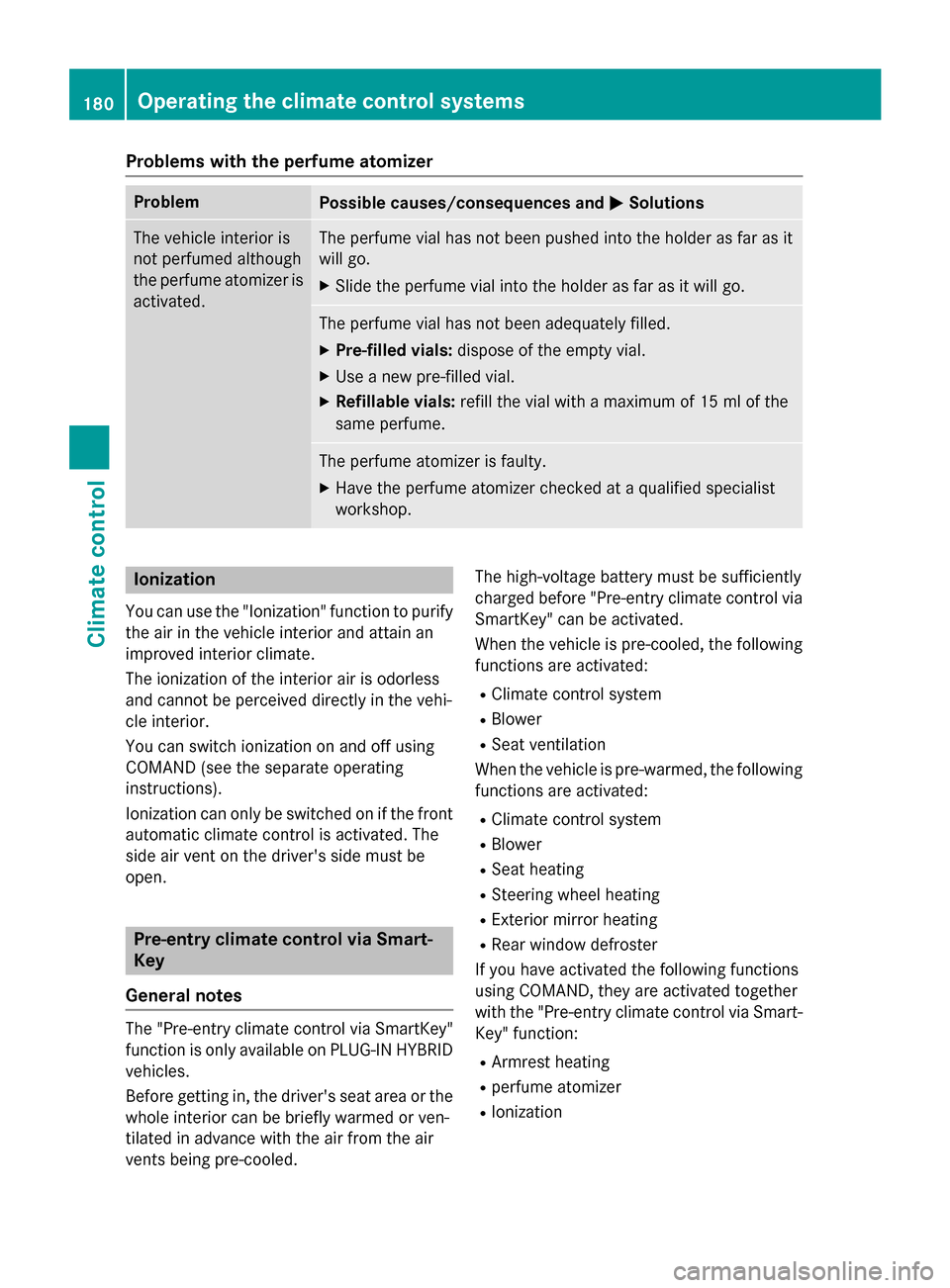
Problems with the perfume atomizer
Problem
Possible causes/consequences and
M
MSolutions The vehicle interior is
not perfumed although
the perfume atomizer is
activated. The perfume vial has not been pushed into the holder as far as it
will go.
X Slide the perfume vial into the holder as far as it will go. The perfume vial has not been adequately filled.
X Pre-filled vials: dispose of the empty vial.
X Use a new pre-filled vial.
X Refillable vials: refill the vial with a maximum of 15 ml of the
same perfume. The perfume atomizer is faulty.
X Have the perfume atomizer checked at a qualified specialist
workshop. Ionization
You can use the "Ionization" function to purify
the air in the vehicle interior and attain an
improved interior climate.
The ionization of the interior air is odorless
and cannot be perceived directly in the vehi-
cle interior.
You can switch ionization on and off using
COMAND (see the separate operating
instructions).
Ionization can only be switched on if the front automatic climate control is activated. The
side air vent on the driver's side must be
open. Pre-entry climate control via Smart-
Key
General notes The "Pre-entry climate control via SmartKey"
function is only available on PLUG-IN HYBRID
vehicles.
Before getting in, the driver's seat area or the whole interior can be briefly warmed or ven-
tilated in advance with the air from the air
vents being pre-cooled. The high-voltage battery must be sufficiently
charged before "Pre-entry climate control via
SmartKey" can be activated.
When the vehicle is pre-cooled, the following functions are activated:
R Climate control system
R Blower
R Seat ventilation
When the vehicle is pre-warmed, the following
functions are activated:
R Climate control system
R Blower
R Seat heating
R Steering wheel heating
R Exterior mirror heating
R Rear window defroster
If you have activated the following functions
using COMAND, they are activated together
with the "Pre-entry climate control via Smart-
Key" function:
R Armrest heating
R perfume atomizer
R Ionization 180
Operating the climate control systemsClimate control
Page 184 of 502

Problems with "Pre-entry climate control via SmartKey"
Problem
Possible causes/consequences and
M
MSolutions "Pre-entry climate con-
trol via SmartKey" can-
not be switched on or
has switched itself off. The condition of charge of the high-voltage battery is under the
specified minimum condition of charge.
X Start the engine when the vehicle is at a standstill.
The engine powers the electric motor. The electric motor oper-
ates as a generator. The high-voltage battery is being charged.
Further information on charging the high-voltage battery via:
R a mains socket (Y page 212)
R a charging station (Y page 216)
R a wallbox (Y page 215) "Pre-entry climate control via SmartKey" has been started more
than twice with the engine switched off.
X Switch on the engine and let it run for more than ten seconds.
X Try again to switch on "Pre-entry climate control via SmartKey". Pre-entry climate control at time of
departure
Important safety notes G
WARNING
If persons, particularly children are subjected to prolonged exposure to extreme heat or
cold, there is a risk of injury, possibly even
fatal. Never leave children unattended in the
vehicle.
General notes The "Pre-entry climate control at departure
time" function is only available on PLUG-IN
HYBRID vehicles.
You can use the "Pre-entry climate control at
departure time" function to cool or heat the
vehicle interior if the engine is not running.
The "Pre-entry climate control at departure
time" function can be activated regardless of
whether or not the vehicle is connected to an electric power supply. The condition of
charge of the high-voltage battery must be
higher than the specified minimum condition of charge, however. When the vehicle is connected to an electric
power supply, priority is given to charging the
high-voltage battery to the specified mini-
mum charge. "Pre-entry climate control at
departure time" is only activated subse-
quently.
The running time of the "Pre-entry climate
control at departure time" function may be
reduced if:
R the vehicle is not connected to an electric
power supply and
R the high-voltage battery is not fully charged
With active "Pre-entry climate control at
departure time" the condition of charge of the
high-voltage battery can be reduced, even if
the charge cable connector is connected.
When the vehicle is cooled, the following
functions are activated:
R Climate control system
R Blower
R Seat ventilation 182
Operating the climate control systemsClimate control
Page 189 of 502
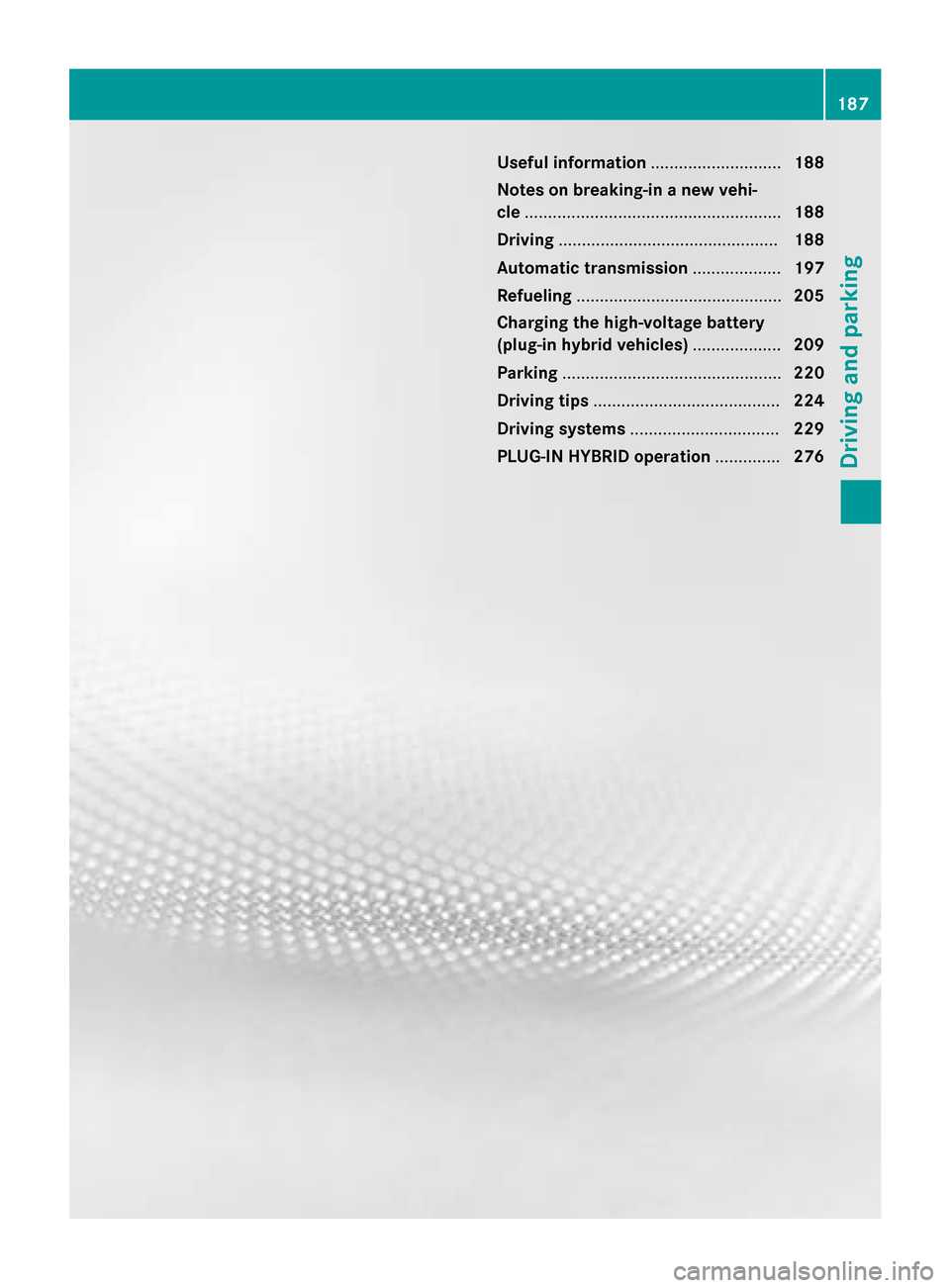
Useful information
............................188
Notes on breaking-in a new vehi-
cle ....................................................... 188
Driving ............................................... 188
Automatic transmission ...................197
Refueling ............................................ 205
Charging the high-voltage battery
(plug-in hybrid vehicles) ...................209
Parking ............................................... 220
Driving tips ........................................ 224
Driving systems ................................ 229
PLUG-IN HYBRID operation ..............276 187Driving and parking
Page 191 of 502

G
WARNING
Unsuitable footwear can hinder correct usage of the pedals, e.g.:
R shoes with thick soles
R shoes with high heels
R slippers
There is a risk of an accident.
Wear suitable footwear to ensure correct
usage of the pedals. G
WARNING
If you switch off the ignition while driving,
safety-relevant functions are only available
with limitations, or not at all. This could affect, for example, the power steering and the brake
boosting effect. You will require considerably
more effort to steer and brake. There is a risk of an accident.
Do not switch off the ignition while driving. G
WARNING
If the parking brake has not been fully
released when driving, the parking brake can:
R overheat and cause a fire
R lose its hold function.
There is a risk of fire and an accident. Release
the parking brake fully before driving off.
! Do not warm up the engine with the vehi-
cle stationary. Drive off immediately. Avoid high engine speeds and driving at full throt-
tle until the engine has reached its operat-
ing temperature.
Only shift the automatic transmission to
the desired drive position when the vehicle is stationary.
Where possible, avoid spinning the drive
wheels when pulling away on slippery
roads. You could otherwise damage the
drive train.
! AMG vehicles:
at low engine oil temper-
atures below 68 ‡ (+20 †), the maximum
engine speed is restricted in order to pro-
tect the engine. To protect the engine and maintain smooth engine operation, avoid
driving at full throttle when the engine is
cold.
Observe the important safety notes for PLUG-
IN HYBRID vehicles (Y page 46). Key positions
SmartKey g
To remove the SmartKey
1 Power supply for some consumers, such
as the windshield wipers
2 Ignition (power supply for all consumers)
and drive position
3 To start the engine
The SmartKey can be turned in the ignition
lock even if it is not the correct SmartKey for
the vehicle. The ignition is not switched on.
The engine cannot be started.
Start/Stop button General notes
All vehicles are equipped with a removable
Start/Stop button.
The Start/Stop button must be inserted in the ignition lock and the SmartKey must be in the
vehicle.
When you insert the Start/Stop button into
the ignition lock, the system needs approx-
imately two seconds recognition time. You
can then use the Start/Stop button.
Pressing the Start/Stop button several times
in succession corresponds to the different Driving
189Driving and parking Z